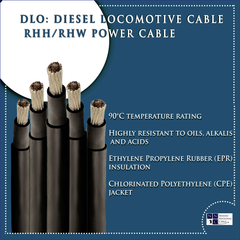What Is A Diesel Locomotive Cable?
A Diesel Locomotive Cable, also known as DLO cable, is a flexible tinned copper portable power cable with EPR and CPE ethylene-propylene rubber insulation and the outer jacket of black chlorinated polyethylene.
A diesel locomotive, where this cable is used, is a railway locomotive that runs on a diesel engine. While a DLO cable takes its name from such a locomotive, it can be used in other machines with diesel engines, such as wind turbines, industrial machines, train wagons, and much more. The primary purpose of the cable is to transmit the power from the generator to the electric-drive motor.
These cables are also used in motor leads, petrochemical drilling, mining, and other industrial machines. These conductors can work in dry and wet conditions at 90°C.

Other Applications of DLO
- As a general building wire.
- To supply power to the traction motors in rail vehicles and other diesel-electric locomotives.
- In onshore and offshore equipment such as for shipboard, oil field, hoisting, cranes, etc.
- In the wiring of transit cars, petrochemical drilling rigs, earthmoving electrical equipment, telecom power supply, and power supply in arc welding.
- For heavy-duty industrial applications
How is DLO Cable Used In Wind Farms?
DLO cable is perfect for large-scale electrical projects in the setting of the wind farm as it is durable and well-adjusted to harsh environments.
Important Info About NEC and RHH/RHW-2 Rating
The name "diesel locomotive cable" is not mentioned in any recent editions of the National Electric Code. However, this does not mean that DLO cable is not approved for use. DLO wire is part of NEC Art. 310 based on their RHH/RHW-2 second rating.
In the National Electric Code, RHH/RHW-2 is a rubber-insulated water-resistant cable approved for direct burial. So, what would make a DLO cable ranked RHH/RHW-2 different from RHH/RHW-2 cable that is not DLO? DLO cable has special bending properties that prevent cables from being damaged because they are often bent around in many of the applications. These bending properties are a key feature of DLO/RHH/RHW-2 double-ranked cable.
The Ampacity Of The DLO Cable
The ampacity of the DLO cable, which can be found in the National Electric Code, is calculated based on the standard DLO cable with the RHH/RHW-2 rating. Here is the allowable ampacity of the DLO Cable based on NEC 2017 310.15(B)(17). The ampacity is calculated both for 75°C and 90°C cable versions.

Construction Of A DLO Cable
Conductors
The DLO cable conductor is made of annealed tinned copper of Class I, with 24 AWG strands. Tin is combined with copper to decrease long-term corrosion by enhancing the power supply's overall conductivity and protecting it from rust. Tin is mainly known for its rust protection. It does not corrode easily compared to many other metals, as it keeps the copper conductor underneath the tin layer safe.
Insulation
These cables' insulation material is of two types: EPDM (Ethylene propylene diene monomer) and EPR (Ethylene Propylene Rubber). From the performance perspective, the difference between those two insulations is insufficient. They have different types of polymers that are cured by different chemical elements.
These materials are highly flexible and are composed of crosslinked coating elements. They can twist and bend, as other insulating materials do, without tearing and wearing. It keeps the conductor safe even in case of fire damage.
Jacket
The layer of the jacket helps mainly in identifying and classifying the wire/cable. Chlorosulphonated polyethylene made up of thermosetting material has a black color jacket covering the conductor.
Lugs
Lugs are nothing but connectors that are used to connect other cables. The DLO cable is connected to another DLO cable used to boost up the power transmission. The lugs are made up of tinned pure copper composition and consist of flared ends with entrance chambers.
A properly rated 2 kV RHH/RHW-2 DLO cable that meets all expected specifications is offered by NNC.


















